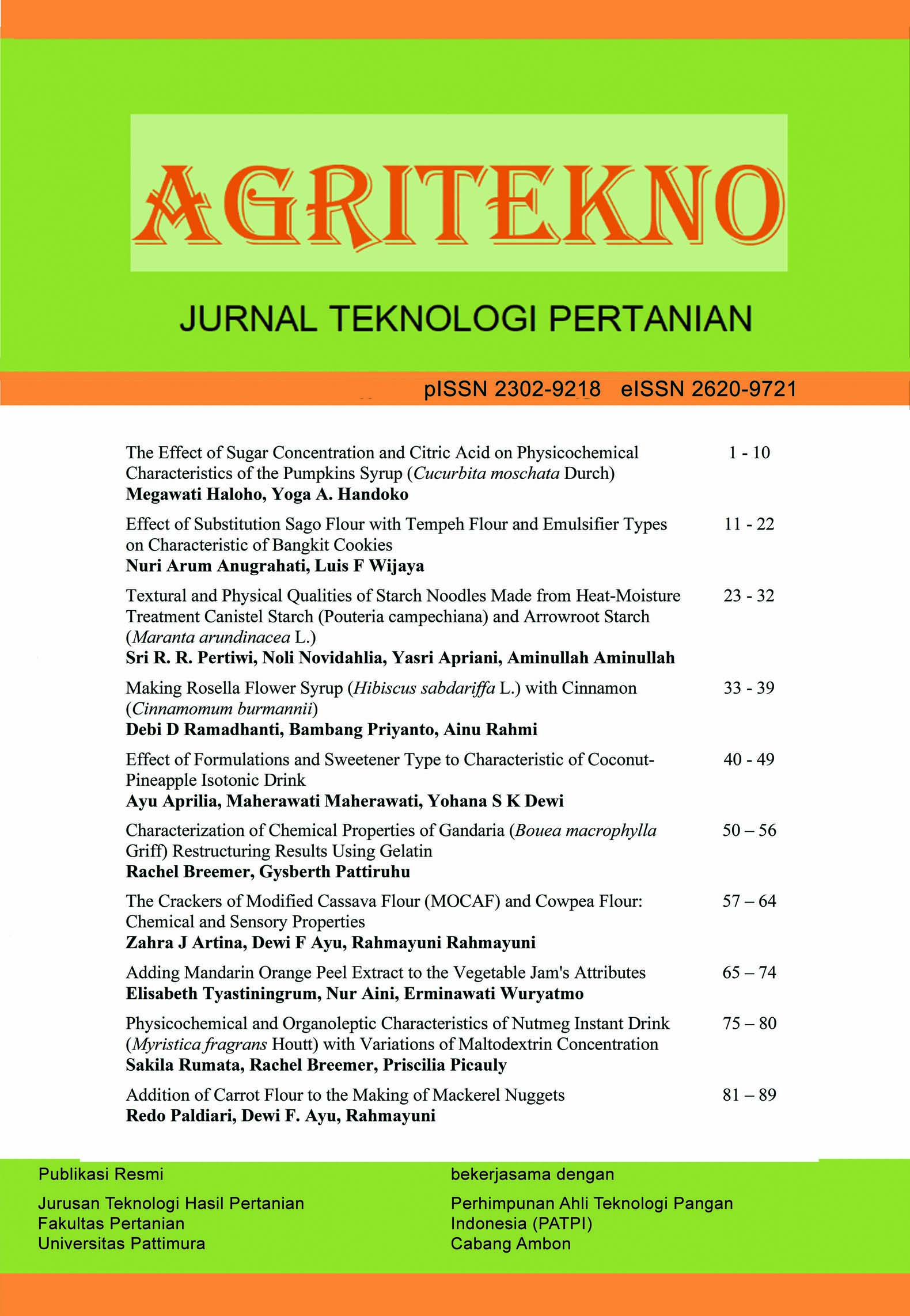The Crackers of Modified Cassava Flour (MOCAF) and Cowpea Flour: Chemical and Sensory Properties
Abstract
Crackers are a type of snack that people of all ages like. They come in many different shapes and flavors and are sold in a lot of places. This research aimed to determine the best formulation of crackers using modified cassava flour (MOCAF) and cowpea flour based on their chemical and sensory properties. A completely randomized experimental design with five treatments and three replications was performed. The treatments were MKT0 (100 g MOCAF), MKT1 (90 g MOCAF:10 g cowpea flour), MKT2 (80 g MOCAF:20 g cowpea flour), MKT3 (70 g MOCAF:30 g cowpea flour), and MKT4 (60 g MOCAF:40 g cowpea flour). Chemical content (moisture, ash, protein, and fat), color analysis with a chromameter, and sensory assessment were observed. Based on the results obtained, 70 g MOCAF:30 g cowpea flour was the best treatment, which had 4.70% moisture, 1.76% ash, 8.34% protein, 17.79% fat, 77.59 L*, 6.46 a*, and 26.57 b* values in the color analysis. The crackers had a cream-brown color, a cowpea aroma, a cowpea taste, and a crunchy texture. The panelists also favored the overall hedonic assessment of the MKT3 crackers with a score of 1.60 (like).
Downloads
References
Agustina, F. C, Subardjo, Y. P., & Sari, H. P. (2017). Pengembangan biskuit MOCAF-Garut dengan substitusi hati sebagai alternatif biskuit tinggi zat besi untuk balita. Jurnal Gizi dan Pangan. 12(2), 129–138
Alimi, J.P., Shttu, T.A., Oyelakin, M.O., Olagbaju, A.R., Sanu, F.T., Alimi, J.O., Abel, O.O., Ogundele, B.A., Ibitoye, O., Ala, B.O., & Ishola, D.T. (2016). Effect of cowpea flour inclusion on the storage characteristics of composite wheat-cowpea bread. Journal of Agricultural and Crops Research, 4(4), 49–59.
Awika, J. M., & Duodu, K. G. (2017). Bioactive polyphenols and peptides in cowpea (Vigna unguiculata) and their health promoting properties: A review. Journal of Functional Foods. 38, 686-697.
Aziah, N., Mohammad, N., & Ho, L.H. (2012). Physicochemical and organoleptic properties of cookies incorporated with legume flours. International Food Research Journal, 19(4), 1539–1543.
Badan Standardisasi Nasional. (1992). SNI 01-2973-1992. Syarat Mutu dan Cara Uji Biskuit. Jakarta. Badan Standardisasi Nasional.
Darmatika, K, Ali, A., & Pato, U. (2018). Rasio tepung terigu dan tepung kacang tunggak (Vigna unguiculata) dalam pembuatan crackers. Jurnal Online Mahasiswa Fakultas Pertanian Universitas Riau, 5(1), 1–14.
Fauziyah, A. F. (2015). Pengaruh perbandingan tepung kacang tunggak dengan tepung mocaf dan persen jumlah lemak. e- Journal Boga, 4(3), 7–13.
Ferdiawan, N., Nurwantoro, & Dwiloka, B. (2019). Pengaruh lama waktu germinasi terhadap sifat fisik dan sifat kimia tepung kacang tolo (Vigna unguiculata L.). Jurnal Teknologi Pangan. 3(2), 349–354.
Hadistio, A., & Fitri, S. (2019). Tepung MOCAF (modified cassava flour) untuk ketahanan pangan indonesia. Jurnal Pangan Halal, 1(1), 13–17.
Jayathilake, C., Visvanathan, R., Deen, A., Bangamuwage, R., Jayawardana, B. C., Nammi, S., & Liyanage, R. (2018). Cowpea: An overview on its nutritional facts and health benefits. Journal of the Science of Food and Agriculture, 98(13), 4793–4806.
Khatarina, S. (2018). Kajian Substitusi Umbi Suweg (Amorphophallus campanulatus B) pada Pembuatan Crackers terhadap Sifat Kimia dan Organoleptik. Skripsi. Bandar Lampung: Universitas Lampung.
Lestari, N. (2017). Inovasi Cookies Sumber Protein Berbahan Kacang Tunggak Sebagai Upaya Pemanfaatan Komoditas Lokal. Skripsi. Malang: Universitas Brawijaya.
Lestari, P. A., Yusasrini, N. L. A., & Wiadnyani, A. A. I. S. (2019). Pengaruh perbandingan terigu dan tepung kacang tunggak terhadap karakteristik crackers. Jurnal Ilmu dan Teknologi Pangan, 8(4), 457–464.
Mahmud, M. K., Hermana, N. A., Nazarina, M., Marudut, S., Zulfianto, R. R., Muhayatun, Jahari, A. B., Permaesih, D., Ernawati, F., Rugayah, Haryono, Fahmida, Sulaeman, A., Andarwulan, N., Atmarita, Almasyhuri, Nurjanah, N., Ikka, N., Sianturi, G., Prihastono, E., & Marlina, L. (2018). Tabel Komposisi Pangan Indonesia (TKPI). Gramedia Pustaka. Jakarta.
Passali, M., Josefsen, K., Frederiksen, J. L., & Antvorskov, J. C. (2020). Current evidence on the efficacy of gluten-free diets in multiple sclerosis, psoriasis, type 1 diabetes and autoimmune thyroid diseases. Journal of Nutrients, 12, 1–26.
Pathare, P. B., Opara, U. L., & Al-Said, F. A. J. (2013). Color measurement and analysis in fresh and processed foods: A review. Food and Bioprocess Technology, 6(1), 36–60.
Permatasari, N., Angkasa, D., Swamilaksita, P.D., Melani, V., & Dewanti, L. P. (2020). Pengembangan biskuit MPASI tinggi besi dan seng dari tepung kacang tunggak (Vigna unguiculata L) dan hati ayam. Jurnal Pangan dan Gizi, 10(02), 33–48.
Prihapsari, F. A., & Nurani, D. (2021). Substitusi tepung kacang tunggak (Vigna unguiculata L . Walp) pada produk cookies. TEKNOBUGA: Jurnal Teknologi Busana dan Boga, 9(2), 155–161.
Setyaningsih, D., Apriyantono, A., & Sari, M. P. (2010). Analisis Sensori untuk Industri Pangan dan Agro. IPB Press.
Sudarmadji, S., Haryono, B., & Suhardi. (1997). Prosedur Analisa untuk Bahan Makanan dan Pertanian. Penerbit Liberty. Yogyakarta.
Tunjungsari, P. (2019). Pengaruh penggunaan tepung kacang tunggak (Vigna unguiculata) terhadap kualitas organoleptik dan kandungan gizi biskuit. TEKNOBUGA: Jurnal Teknologi Busana dan Boga, 7(2), 110–118.
Copyright (c) 2023 The Author(s)

This work is licensed under a Creative Commons Attribution-ShareAlike 4.0 International License.
Authors who publish with this journal agree to the following terms:
- Authors retain copyright and grant the journal the right of first publication with the work simultaneously licensed under a Creative Commons Attribution License that allows others to share the work with an acknowledgement of the work's authorship and initial publication in this journal.
- Authors are able to enter into separate, additional contractual arrangements for the non-exclusive distribution of the journal's published version of the work (e.g., post it to an institutional repository or publish it in a book), with an acknowledgement of its initial publication in this journal.
- Authors are permitted and encouraged to post their work online (e.g., in institutional repositories or on their website) prior to and during the submission process, as it can lead to productive exchanges, as well as earlier and greater citation of published work (See The Effect of Open Access).









